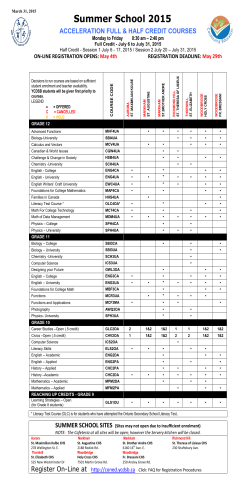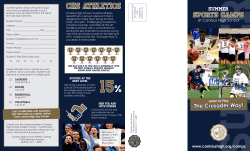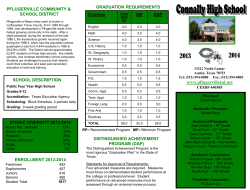
TECHNOLOGY PLAN COVER SHEET : Carmel High School
TECHNOLOGY PLAN COVER SHEET SCHOOL: Carmel High School PRINCIPAL: John Williams TECHNOLOGY COORDINATOR(S): Ryan Ringenberg MEDIA SPECIALIST(S): Bonnie Grimble, John Shearin, Lynette Gross, Connie Mitchell TECHNICIAN(S): Terry Howell, James Lefton, Chris Wheeler, Madonna Gumm NAME THE MEMBERS OF YOUR TECHNOLOGY COMMITTEE. CHS TECH CADRE 2005-06 Mike Lee—Art Stacie Fowler—Business Kathy Mehlhop—Business Jim Streisel—Comm. Jim Peterson—Drama Enid Baines—Eng. John Love—Eng. Brenda Lester—F&CS Patrcia Brinegar—F&CS John Coghlan—Ind. Tech Cindy Bensinger—Math Jan Mitchener—Math Bonnie Grimble—Media Fred McGuire—PE/Health Kathy Buck—PE/Health Bill Baker—Science Kathy Hallett—Science Jeff Young--Science Jill Grimes—Soc. St. Amanda Holman—Soc St. Susan Kruse—Sp. Services Caren Rickett—World Lang. Karen Grenda—World Lang. Susie Deneen—World Lang. DESCRIBE YOUR TECHNOLOGY COMMITTEE MEETING SCHEDULE. The CHS Tech Cadre meets one time a month to discuss current technology issues in the building and to plan in-service sessions for the staff. The Tech Coordinator, Media Specialists, and Technicians also communicate periodically and plan to set up more regular meetings throughout the year. LIST YOUR PUBLIC LAW 221 SCHOOL IMPROVEMENT GOALS. All students will improve writing skills across the curriculum. All students will improve reading comprehension skills across the curriculum. All students will improve critical thinking skills. INDIVIDUALIZED BUILDING TECHNOLOGY PLAN ALL RESPONSES SHOULD ALIGN WITH YOUR SCHOOL IMPROVEMENT GOALS. 1. DESCRIBE HOW YOUR SCHOOL INTEGRATES TECHNOLOGY AND THE INTERNET INTO THE CURRICULUM TO SUPPORT YOUR SCHOOL IMPROVEMENT GOALS. Carmel High School’s students are afforded a myriad of opportunities to use technology and the Internet as a learning tool within the curriculum of individual departments and courses to improve reading comprehension, writing, and critical thinking skills. CHS students are able to use technology to access, collect, organize and analyze data. Computers are used throughout the building to access information from the World Wide Web, and paid subscription services which provide primary sources, data bases, reference materials and periodicals. Many classes use technology to collect information. This is particularly evident in the science department where Vernier probes are connected to computers to digitally capture raw data in a wide range of disciplines. The Industrial Technology and Math departments also use technology to collect “real world” data in several classes. Many software applications are used in several departments to organize data. This would include everything from simple Excel spreadsheets to highly sophisticated programs which will take data and convert it into several types of graphs or charts. The most important use of technology and data is when the students analyze the data. These are the end level higher order thinking skills that are facilitated when the technology helps simplify the access, collection and/or organization of large amounts of data. Another large category of student use of technology as a learning tool is in the area of assessment. This may be most evident when students use technology to demonstrate their skills in the areas of the school improvement goals through presentations. Students create Power Point presentations, documents created in desk top publishing applications, Web pages, photographic slide shows, and video presentations in order to demonstrate the knowledge and skills they have acquired and in the process improve their communication skills. Many teachers also provide a wide range of on-line assessments which can often be accessed 24/7 by students from their homes. In some math, world language and performing arts technology labs the teachers are able to access individual student work to make assessments. Students are also provided the opportunity to use technology in the general area of remediation which provides a more individualized environment for learning. Students who have difficulty mastering standards necessary for passing ISTEP+ extensively use software designed to address their specific deficiencies. This is particularly true in the areas of writing and reading comprehension. Student in our alternative school use Plato to improve their skills and recapture credits. Many of our departments use audio and/or video recordings of individual assessment presentations to allow for self-assessment and improvement (e.g., world languages, drama, speech, debate, band, orchestra, choir, and physical education). The English department uses software called Turnitin.com which allows the student to analyze their writing and check for plagiarism prior to turning in an assignment. In many cases the standards of a course actually involve the teaching of the technology as an end product. This would include many well known applications such as Microsoft Office Suite, Front Page, JAVA, HTML, PageMaker, and Photoshop. In some cases vocationally oriented classes are teaching the “industry standard” technology that is being used in the “real world” as part of the method of teaching the standards. This would include classes such as Radio, Television, Auto Mechanics, Web Design, Journalism, Photojournalism, Accounting, Computer Assisted Design, Desktop Publishing, Animation, Electronics, Musical Theory (composition) and Marketing. Sometimes applications are used to teach important concepts within classes such as calculating mortgage and interest rates, tracking an investment portfolio, retail and marketing procedures (inventories, receiving, checking, and producing price tags for the stores), digital editing of photography and video, and editing skills using word processing. Virtually all of these uses involve critical thinking skills. Teachers also use technology in a variety of ways to assist learning. Digital projectors are being used with presentation methods such as Power Point, DVD/VHS, digital field trips/story telling, document projectors, web pages, primary sources, and projection microscopes. Technology is also being used to preserve portfolios and to preserve excellent examples of student work for demonstration purposes. Teachers also use available technology to better communicate with students by using email, Parent Connect XP, Quiz, emailed progress reports, and many teachers have created their own web pages. Teacher web pages often include notes, assignments, and make up work. Teachers who use technology as an administrative tool find this work easier and it creates more time for student instruction. Some of our PLCs use our shared drive to collaborate and to share stored information. 2. DESCRIBE THE PROFESSIONAL DEVELOPMENT STRATEGIES YOUR SCHOOL USES TO PROVIDE INSERVICE TO TEACHERS AND STAFF. In 2003, a survey was conducted at CHS to gauge the strengths and weaknesses of the teacher and staff’s use of technology. The results highlighted some specific areas of weakness, such as the use of Microsoft Office programs, utilizing shared folders, using Intergrade effectively, and web-page design. These areas of weakness, among others, have been the focus of in-service training sessions conducted three to four times a semester since 2003. Most training sessions have been led by the CHS Tech Cadre or technicians in the building and have been held during the school day during teachers’ prep periods. The exception has been webpage design training which has been led by Christi Cloud and held each fall and spring during a series of after-school sessions. It is the goal of the CHS Tech Cadre in the spring of 2006 to implement more consistent and frequent technology training to the staff through weekly PD Wednesdays (Professional Development Wednesdays). The teachers and staff will be polled to determine the biggest technological needs. They will also be given the opportunity to suggest topics other than those on the survey. Once a list of ideas has been compiled the CHS Tech Cadre and other staff members will be asked to help lead the weekly sessions. Individuals outside of CHS will also be given the opportunity to help lead these training sessions. With weekly in-services, there will be a greater opportunity for teachers to participate and a greater opportunity for them to inspire others. Teachers will be encouraged to share new ideas and skills they learn with their PLC group. Overall, the ultimate goal of our weekly in-service strategy is to create a culture at CHS where teachers are excited about trying new ideas in their classroom, particularly ideas that implement technology. 3. DESCRIBE YOUR PROCESS FOR ASSESSING THE NEED FOR THE INTERNET, TELECOMMUNICATIONS AND OTHER TECHNOLOGY IN THE SCHOOL. The Educational Technology Coordinator and the Technology Cadre at Carmel High School are responsible for recommendations regarding internet, telecommunications and other technology needs of the school. Throughout the year department chairs solicit input from the members of their department concerning the technology needs specifically for their department and for Carmel High School as a whole. The “Tech Cadre” meets once a month and continually assesses technology needs. In the fall of each year the department chairs and Tech Cadre supply written information and data explaining requests for new technology and give a presentation to the building administrators and other department chairs and staff. There are always more requests than there is money. This group of people works diligently sometimes well into the night to reach consensus on the priorities for that year. The assistant principal in charge of technology chairs the procedure. When discussions are over, everyone understands why decisions were made and the group as a whole has agreed. 4. DESCRIBE YOUR STRATEGY FOR CONTINUOUSLY ASSESSING AND EVALUATING THE OVERALL TECHNOLOGY PROGRAM. This is primarily done by the Educational Technology Coordinator and the Technology Cadre which annually surveys teachers to determine needs and progress toward mastery of technology skills. The Cadre represents all departments and meets monthly to assess and evaluate how the overall technology plan is being implemented. In addition each department will evaluate how the technology plan is being implemented within the department and how it is helping to cover state standards within the curriculum of each subject. The School Improvement Committee is charged with the overall evaluation of the School Improvement Goals and how effectively the technology is being used to help achieve improvement in each of those areas. The budget process reflects the annual survey results when each department is asked to explain how current technology is being used to assist instruction and how new technologies could be used to improve that instruction. Budgetary decisions are generally made on how effectively a department is currently using their technology and the likelihood that new technologies will also be effectively used.
© Copyright 2025





















